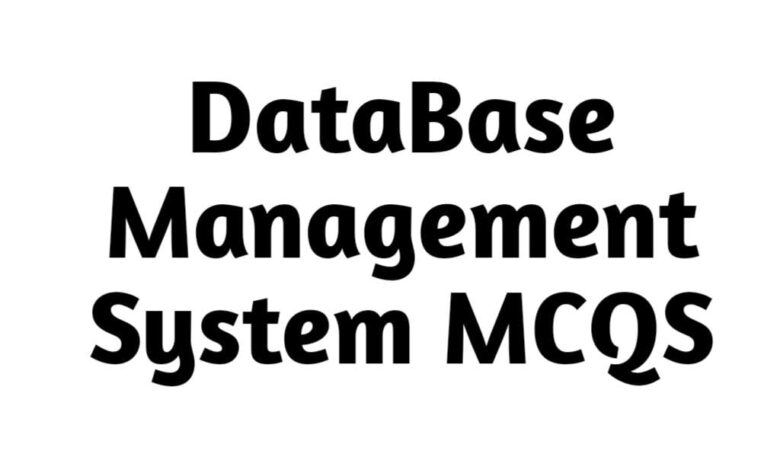
Computer Data Base Management Mcqs
1. A database is an organized collection of __________ related data.
a. Logically
b. Physically
c. Loosely
d. Badly
2. The objectives of database management systems include:
a. Database integrity
b. Data integration
c. Availability
d. All
3. Data that causes inconsistency lacks:
a. Good data
b. Data integrity
c. Data redundancy
d. Data anomaly
4. The major component of DBMS is called:
a. Database manager
b. File manager
c. Data manager
d. All
5. Which of the following enables the user to modify data structures without affecting existing programs that use them?
a. Data dependence
b. Data independence
c. Data integration
d. Data
relationships
6. Which one of the following is an advantage of database management approach?
a. Program data independence b. Reduced security
c. Increased Duplication of data
d. None
7. A set of related files created and managed by a DBMS is called:
a. Field
b. Record
c. Database
d. None
8. Roll No of a student should be stored in a
a. Record
b. Field
c. Cell
d. File
9. Which of the three schemas used in three-schema model is a complete logical view of database?
a. External
b. Internal
c. Implementation
d. Conceptual
10. The older logical database model that organizes data in a tree like structure is
a. Hierarchical
b. Network
c. Relational
d. Object
11. DBA stands for
a. Database Administrator
b. Database Application
c. Database Authority
d. None
12. The advantage of partitioning is
a. Efficiency
b. Extra space and update time
c. Both A and B
d. None
13. Basic data distribution strategies include:
a. Centralized
b. Partitioned
c. Replication
d. All
14. Characteristics of an entity are called
a. Entity
b. Attribute
c. Identifier
d. Relationship
15. Which of the following represent entities?
a. Teacher
b. Student
c. Doctor
d. All
16. An identifier may be
a. Unique
b. Non-unique
c. Composite
d. All
17. A single-entity instance of one type related to a single-entity instance of another type?
a. One to one Relationship
b. One to many Relationship
c. Many to many relationship
d. None
18. A single-entity instance of one type related to many entity instances of another type?
a. One to one relationship
b. One to many relationship
c. Many to many relationship
d. None
19. Many entity instances of one type be related to many entity instances of another type?
a. One to one relationships
b. One to many relationship
c. Many to many relationship
d. None
20. Which of the following is a one to many relationship?
a. Student Reg_No
b. Person_Automobilec. Mother_Sond. Both b and c
21. Which of the following is related to modality?
a. Optional
b. Mandatory
c. Unidirectional
d. Both a and b
22. A relationship consists of three entities are called
a. Unary
b. Binary
c. Ternary
d. None
23. ________ indicates the maximum number of entities that can be involved in a relationship?
a. Minimum cardinality
b. Maximum cardinality
c. Both a and b
d. None
24. In an E-R Diagram, an ellipse represents an:
a. Entity class
b. Weak entity
c. Relationship
d. Attribute
25. An attribute which consists of a group of attributes is called
a. Multi-valued attributes
b. Composite attributes
c. Composite identifiers
d. Identifiers
26. _________ refers to relationships that are subtypes, when the identifiers of the entities are
same.
a. HAS-A relationships
b. IS-A relationships
c. Binary Relationships
d. None
27. An entity type whose existence depends on another entity is called _________ entity.
a. Strong
b. Weak
c. Dependent
d. Variant
28. An identifier of an entity instance:
a. May be unique
b. Must be unique
c. May consist of more than one attribute d. a and c
29. _______ refers to the degree of relationship.
a. Number of entities
b. Maximum cardinality
c. Minimum cardinality
d. None
30. The type of attribute that is composed of other attributes?
a. Simple
b. Meta
c. Group
d. Compound
31. Composite and compound objects together known as:
a. Hybrid objects
b. Association objects
c. Subtype objects
d. Archetype objects
32. Which of the following contains at least one object attribute?
a. Simple objects
b. Composite objects
c. Compound objects
d. Hybrid objects
33. Which of the following are used to represent the specialization of objects?
a. Hybrid objects
b. Association objects
c. Subtype objects
d. Archetype objects
34. Which of the following refers to an attribute whose maximum cardinality is 1?
a. Multi value attribute
b. Non-object attribute
c. Paired attribute
d.Single value attribute
35. A group identifier
a. Has more than one attribute
b. Identifies a group of instances
c. Identifies a group of attributes in an object
d. Is the identifier for a group of
semantic objects
36. Foreign key is found in
a. Parent table
b. Dependent table
c. Pivot table
d. Index table
37. Two dimensional table consists of a data is called
a. Group b. Set c. Declaration d. Relation
38. An index can be used to:
a. Improve the performance of the database
b. Document the structure of the database itself
c. Reduce data dependency for application programs
d. All
39. Which of the following are properties of relations?
a. Each attribute has a unique name
b. No two rows are identical
c. No multivalued attributes
d. All
40. How many primary keys can a table have?
a. One
b. At-least one but not more than two
c. No limit
d. None of above
41. Choose the most appropriate primary key?
a. Student’s name
b. Student’s address
c. Student DOB
d. Student’s Reg_No
42. A candidate key is
a. Primary key
b. Primary key selected to be the key of a relation
c. An attribute or group of attributes that can be the primary key
d. All
43. In 2NF, which dependency is removed?
a. Functional
b. Partial
c. Associative
d. Transitive
44. In 3NF, which dependency is removed?
a. Functional
b. Partial
c. Associative
d. Transitive
45. Each foreign key value must match a primary key value in the other relation is called:
a. Referential integrity constraint
b. Entity key group rule
c. Both
d. None
46. Different attributes in two different tables having same name as referred to as:
a. Synonym
b. Homonym
c. Acronym
d. Mutually Exclusive
47. In functional dependency, the attribute on the left side is called:
a. Candidate key
b. Determinant
c. Foreign key
d. Primary key
48. The main purpose of normalization is to:
a. Increase relations
b. Remove anomalies
c. Increase Redundancy
d. None
49. A functional dependency between two or more non-key attributes is called:
a. Partial dependency
b. Partial non-key dependency
c. Transitive dependency
d. None
50. Restrictions and checks on a relation are called:
a. Deletion anomaliesa
b. Insertion anomalies
c. Modification anomalies
d. Referential integrity constraints
51. If every determinant is a candidate key, then the relation is in
a. First Normal form
b. Second Normal form
c. Third Normal form
d. BCNF
52. A relation is in BCNF and has no multi valued dependencies
a. Second
b. Third
c. Fourth
d. Domain key Normal Form
53. If A determines B but B does not determine A, then
a. One to one relationship
b. Many to one relationship
c. Normalized relationship
d. Many to many relationship
54. Which of the following should not be in a relational table?
a. Entity
b. Attribute
c. Repeating group
d. Relationship
55. These objects can be represented by a single relation in the database:
a. Simple objects
b. Composite objects
c. Compound objects
d. Hybrid objects
56. Atleast two relations are required to represent this type of object:
a. Simple objects
b. Composite objects
c. Compound objects
d. Hybrid objects
57. These objects require atleast three relations for their representation
a. Association objects
b. Composite objects
c. Compound objects
d. Hybrid objects
58. SQL is
a. Procedural language
b. Non-procedural language
c. Not a data sub language
d. None
59. To remove duplicate rows this qualifier must be specified
a. ONLY
b. UNIQUE
c. DISTINCT
d. SINGLE
60. Which SQL keyword is used to delete a table’s structure?
a. Delete
b. Drop
c. Update
d. Alter
61. In SQL asterisk (*) means:
a. All columns of table are selected
b. All records meeting the criteria are returned
c. All records with partial criteria met are returned
d. None
62. In an SQL query, which built in function is used to compute the number of rows in a table?
a. AVG b. MAX c. MIN d. COUNT
63. In an SQL query, which keyword is used with built in function to group rows that have the same value in a specified column together?
a. GROUP BY
b. ORDER BY
c. SELECT
d. SORT BY
64. In an SQL query, which SQL keyword is used to implement a subquery?
a. GROUP BY
b. HAVING
c. ORDER BY
d. SELECT
65. In an SQL query, which keyword is used to specify the names of tables to be joined?
a. FROM b. HAVING c. JOIN d. SELECT
66. In SQL, which keyword is used to specify the condition for a join operation?
a. FROM
b. HAVING
c. WHERE
d. SELECT
67. Which SQL keyword is used to change a column value?
a. CHANGE b. INSERT c. SELECT d. SET
68. Which of the following are five built in functions of SQL:
a. COUNT, SUM, AVG, MAX, MIN
b. SUM, AVG, MIN, MAX, MULT
c. SUM, AVG, MULT, DIV, MIN
d. SUM, AVG, MIN, MAX, NAME
69. Which of the following is not an SQL statement used on a single table?
a. SELECT with WHERE
b. SELECT with GROUP BY
c. SELECT with GROUP BY and HAVING
d. SELECTION
70. Which of the following is not an SQL command category:
a. DDL b. DML c. DGL d. DCL
71. Which is NOT an advantage of using a view?
a. Simplify query commands
b. Provide data security
c. Enhanced programming productivity
d. Decrease system overhead
72. Which keyword is NOT used in most data retrieval statements?
a. Select b. As c. From d. Where
73. Which can only interact with relational database and table like data structure?
a. OLE DB b. ODBC c. ASP d. All
74. The ODBC standard defines a means of doing which of the following?
a. Start transactions
b. Rollback transactions
c. Create a connection
d. All
75. The intermediary between application and DBMS drivers in ODBC architecture is
a. Driver manager
b. OLE DB interface
c. ODBC driver
d. Data source
76. ODBC interface are abstractions of _________
a. OLE objects
b. Native DBMS access methods
c. Driver manager
d. DBMS data sources
77. A driver ________ is a set of functions that the application can call to receive services
a. OLE object
b. DBMS data source
c. API
d. System
78. One _____ key can be created for each table
a. Primary
b. Foreign
c. Unique
d. None of them
79. With SQL, how do you select all the columns from a table names “Persons”?
a. SELECT [all] FROM Persons
b. SELECT All Persons
c. SELECT * Persons
d. SELECT * FROM Persons
80. A table is in 3NF if it is in 2NF and it contains no partial dependencies
a. True
b. False
c. Statement is not clear
81. DDL stands for
a. Database Designing Language
b. Data Dictionary Language
c. Data Definition Language
d. Database Directory Language
82. Relational model creator _____
a. Relational Thomas
b. E.F.Codd
c. Relational CODD
d. R.F Thomas
83. _________ is an operation that select specified attributes from a relation
a. Selection
b. Projection
c. Product
d. Difference
84. Which of these is not an anomaly?a. Insertion
b. Deletion
c. Modification
d. Creation
85. Foreign key may contain null values
a. True
b. False
c. Statement is not clear
86. You can use arithmetic operators in any clause of a SQL statement except the _____ clause
a. SELECT
b. FROM
c. WHERE
d. None of them
87. You can place the sub-query in the SQL-ORDER BY Clause:
a. True
b. False
c. Statement is not clear
88. If Student and Course participate in a relationship then it is
a. Unary Relationship
b. Binary Relationship
c. Ternary Relationship
d. Coupled Relationship
89. A relation is in _______ normal form, if all non-key attributes are dependent on all of the key
a. Second
b. Third
c. Boyce Codd
d. Fourth
90. What is a tuple?
a. Another name for the key linking different tables in a database
b. An attribute attached to a record
c. Another name for a table in an RDBMS
d. A row or a record in a database table
91. Which of the following is a problem of file management system
a. Difficult to update
b. Data redundancy
c. Program dependence
d. All of above
92. Which of the following fields in a student file can be used as a primary key?
a. Class
b. CNIC
c. Marks Obtained
d. Subject
93. A data dictionary is a special file that contains:
a. The names of all fields in all files
b. The data types of all fields in all files
c. The widths of all fields in all files
d. All of them
94. What is the language used by most of the DBMS for helping their users to access data
a. High level language
b. SQL
c. HTML
d. Java
95. What type of join is used when you wish to include rows that do not have matching values?
a. Equi-join
b. Natural-join
c. Outer-join
d. All of them
96. Which group function ignores null values?
a. Avg() b. Count(*) c. Sum() d. a & c both
97. The _________ of two relations is the concatenation of every tuple of one relation with every
tuple of a second relation
a. Selection
b. Projection
c. Product
d. Difference
98. Which of the following constraints enforces entity integrity?
a. PRIMARY KEY
b. FOREIGN KEY
c. CHECK
d. NOT NULL
99. Which of the following is not true about relational tables?
a. Column values are of the same kind.
b. Each row is unique.
c. Each column must have a unique name.
d. The sequence of rows is significant
100. In a conceptual model for a university, what type of relationship exists between Grade
and Student entities?
a. 1:1 b. 1:M c. M:M d. Ternary
101. Which of the following is not a benefit of normalization?
a. Minimize insertion anomalies
b. Minimize deletion anomalies
c. Minimize updation anomalies
d. Maximize redundancy
102. A collection of concepts that can be used to describe the structure of a database
a. Database
b. DBMS
c. Data model
d. Data
103. Which of the following concepts is applicable with respect to 2NF?
a. Full functional dependency
b. Any kind of dependency
c. Transitive dependency
d. Non-transitive dependency
104. User rights information is stored in
a. Physical database
b. Catalog
c. Logical database
d. Buffer
105. A description on a particular collection of data using the given data model
a. Database
b. Schema
c. None of the above.
d. Relation
106. If K is a foreign key in relation R1, then
a. every tuple of R1 has a distinct value for K.
b. K cannot have a null value for tuples in R1.
c. K is a key for some other relation
d. K is a primary key for R1.
107. The ER- data model is an example of:
a. Physical database
b. Logical database
c. Relational
d. Conceptual database
108. In a conceptual database model, which of the following most likely represents a valid
identifier for a class grades?
a. StudentID
b. StudentID, CourseID
c. StudentID, CourseI D, Instructor
d. StudentID, CourseSectionID
109. A ______ is used to maintain a connection between the users of the database system
a. Mail server
b. File Server
c. Client-server
d. None of the given.
110. Consider two sets A and B. A contains 2 elements and B contains 3. How many elements do their
Cartesian product contains?
a. 6 b. 4 c. 5 d. 10
111. UPDATE command belongs to which type of Classification
a. DML b. DDL c. DCL d. DQL
112. The _________ function helps reduce the need to use multiple OR conditions
a. Like b. IN c. AND d. Between
113. Which of the flowing clauses allows to sort the records in result set?
a. Where b. From c. Order By d. Having
114. In SQL queries, while creating tables or relations in database, key columns may be specified by
a. Null
b. Not Null
c. Data Type
d. None of the above
115. Identify the language which is used to specify database schema.
a. DCL
b. DML
c. DDL
d. None of the above
116. What happened if the Where clause is omitted from a Delete Statement?
a. All record from the table are deleted
b. No record from the tables will be deleted
c. First record of the tables will be deleted
d. The statement will not be executed and will give a syntax error
117. Which of the following is a String function in SQL
a. Count b. LEN c. SQRT d. SIN
118. Revoke is a __________ Statement
a. Data Definition
b. Control Access
c. Data Manipulation
d. Data Description
119. Truncate command response time is ____ as compared to Delete command.
a. Poor b. Same c. Better d. worst
120. Which of the following is used to filter rows according to some condition(s)?
a. SELECT
b. FROM
c. WHERE
d. UPDATE
121. Which language is used to permit or prohibit access to a table?
a. DCL b. DDL c. DML d. All of the above.
122. Data Manipulation Language (DML) is the set of commands used to maintain and query a database including updating, inserting, modifying and retrieving data.
a. True
b. FALSE
123. Which of the following is NOT a DDL command?
a. Create DB
b. Create table
c. Delete
d. Drop
124. Which of the following function falls in the category of Aggregate functions
a. SUM b. MIN c. MAX d. All of the above
125. Value of a function in SQL is always determined by the input parameters
a. TRUE
b. FALSE
126. Identify the basic part(s) of a SELECT statement?
a. SELECT
b. FROM
c. Both SELECT and FROM
d. DISTINCT
127. GRANT is a ______________ Command
a. DDL
b. DML
c. DCL
d. None of the above
128. Objective of an order by clause is to display or arrange output of a select statement in
a particular order.
a. True
b. False
129. A __________ is established when the value of one attribute is dependent on the value of another attribute
a. primary key
b. data anomaly
c. dependency
d. transitive relationship
130. Data redundancies produce unusual and undesirable data management problems caused by __________.
a. transitive requirements
b. dependencies
c. normalization
d. data anomalies
131. Metadata provide the description of the data characteristics but do not describe the set relationships that link the data found within the database
a. True
b. False
132. A database that is primarily designed to support a company’s day-to-day operations is called a data warehouse.
a. True
b. False
133. A record is a logically connected set of one or more fields that describes a person,
place, or thing.
a. True
b. False
134. The final outcome of a natural JOIN operation yields a table that does not include the
unmatched row
a. True
b. False
135. In a relational table, each column represents an attribute and each column has a
distinctive name.
a. True
b. False
136. In a relational table, each value in a column must conform to the same data format
a. True
b. False
137. A key consists of one or more attributes that determine other attributes
a. True
b. False
138. A primary key can be defined as a superkey with redundancies.
a. True
b. False
139. To maintain entity integrity, a null value is permitted in the primary key
b. True
b. False
140. A ____ system is composed of software, hardware, procedures, and people.
a. Software b. computer c. file d. database
141. ____ are the people who run the organization’s daily operations.
a. End users
b. Managers
c. Database programmers
d. Data practitioners
142. A telephone number, a birth date, and a customer name are all examples of:
a. Data b. Record c. File d. Database
143. A logically connected set of one or more fields that describes a person, place, or thing is a(n):
a. Data b. A record c. File d. Database
144. Metadata is:
a. raw facts
b. data about data
c. user created data
d. warehoused data
145. A relational database is a group of ____.
a. common fields
b. field values
c. records
d. tables
146. Each row in the relational table is known as an entity ____.
a. Instance
b. relationship
c. attribute
d. model
147. Which model represents the end user’s view of the database?
a. Internal
b. Conceptual
c. Physical
d. External
148. Which model operates at the lowest level of abstraction?
a. Conceptual
b. Internal
c. External
d. Physical
149. What type of relationship is expressed with the phrase “Painter paints Painting”?
a. 1:M b. 1:1 c. M:1 d. M:N
150. What type of relationship is expressed with the phrase “Employee manages Store”?
a. 1:M b. 1:1 c. M:1 d. M:N





